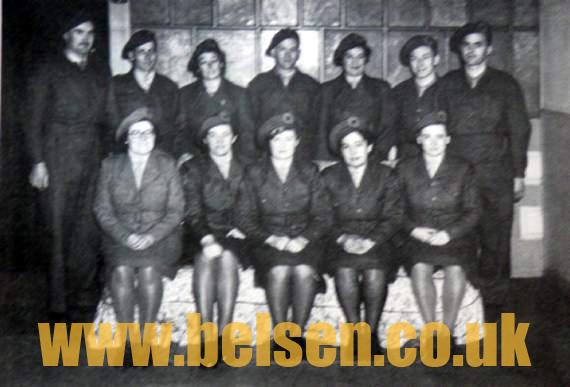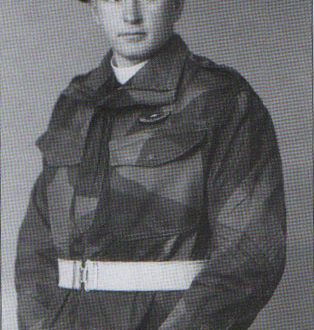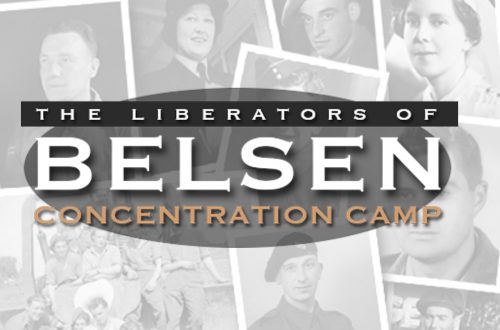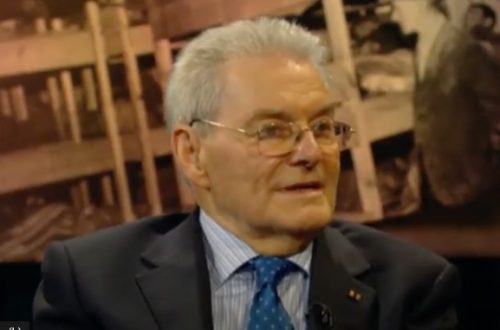Marjorie Ashbery
THE Post has been researching the life of a local woman, who was involved in a remarkable event in world history — the relief of the Bergen-Belsen concentration camp in 1945.

It is rare when one person’s efforts in such a major event would go unrecognised, but little was known about local lady Marjorie Ashbery, who lived in Boscastle for many years, and her time spent in Europe during the Second World War.
Marjorie, also known as ‘Ash’ to her close friends, was a PE teacher at three Post area schools in Launceston, Bude and Camelford, but in her younger days spent a period of time with the Red Cross’ Friends’ Relief Service during the Second World War, having wanted to have had a direct role in the war efforts. Most notably, it is known that Marjorie was involved in the liberation of Bergen-Belsen in April 1945, after British forces carried out the relief of the site from Nazi troops from April 15 of that year.
The Post was first made aware about Marjorie in late January of this year, after a former pupil of Sir James Smith’s school, Yvonne Chidley, on a Facebook post remembering those who died during the Holocaust, spoke about her memories of her teacher — being Marjorie — who told her class back in the 60s about her time spent with the Red Cross during the relief of the concentration camp. When asked about the information Yvonne had on Marjorie, she said: “The teacher’s name was Miss Marjorie Ashbery. She taught me at Sir James Smith’s from 1963 to 1965. I seem to remember she lived in Boscastle, possibly at Well Farm (meaning Welltown Manor). She was grey-haired, so possibly was nearing retirement by that time.
“At the time, I didn’t think a lot about her comment. However, in later years when I saw footage of the relief of Belsen, her words came back to me and I understood the horrors she had witnessed.”
Yvonne was unable to say any more than that, as Marjorie had never spoken about the subject again, or gone into any great length of detail.
This seems to have been a reoccurring theme throughout the Post’s research on this lady. It is now clear that Marjorie did not care to reminisce about this time in her life, which she went on to take to the grave with her 18 years ago.

According to the Imperial War Museum, British forces liberated Bergen-Belsen, which was formerly a prisoner of war camp, on April 15, 1945. Forces found 60,000 people in the camps, most of which were ill, starving and deprived of basic needs such as sanitation, with thousands of dead bodies lying unburied on the site.
The relief of the camp involved burying the dead, containing the spread of disease, restoring the water supply and distributing food to those who needed it. Marjorie is believed to have been one of the first people on scene, and has since been quoted in ‘Forgotten Voices of the Second Word War’, written by Max Arthur, where at one point she describes the awful moment when she could feel a man’s spine through his stomach due to malnutrition.
As the Post first began researching, Tintagel man David Flower got in touch, explaining that Marjorie was a teacher at Sir James Smith’s School in Camelford and had lived at Welltown Manor in Boscastle for some time before selling the magnificent property on to the Fanshawe family and retiring to Wiltshire.
John Fanshawe, who has been pivotal in helping the Post with this story and directing us to further sources, remembered Marjorie well. At the age of around 12, John’s father, Peter, bought Welltown Manor from Marjorie in 1969. He said: “We knew Marjorie quite well and saw quite a lot of her. She was known to quite a few people.”
And that she was. Boscastle-based artist and sculptor, Carole Vincent, was a friend and colleague of Marjorie’s. They both taught at Sir James Smith’s School.
Referring to her as ‘Ash’, Carole said that she remembers Marjorie had told her that she was ‘one of the first to go into Belsen’ during the relief of the concentration camp, but was unable to go any further than army troops.
“I do know she was one of the first to go into Belsen,” Carole said. “She was the deputy head at Sir Jim’s, which started as a grammar school in 1962. I taught with her when I first went there.”
Carole explained that Marjorie was a keen gardener, creating ‘wonderful floral displays’ in her garden, and was a teacher of PE. “Ash lived in Boscastle for quite a long time, before moving to Wiltshire,” Carole continued. “She left to be closer to her sister, I think. She was very much her own person.”
A lifelong friend, Vivian Hircock, had many fond memories of Marjorie, who was also Vivian’s daughter’s godmother.
“Marjorie was my daughter’s godmother, and we always called her ‘Aunty Ash’. She was a Quaker, and went on to live in Wiltshire because she had a sister there.
“She was a typical school mistress — if you were naughty, you knew about it. But she was very private, she didn’t talk about things — that’s just how it was back then, you didn’t talk! You didn’t argue with her, either! She was a school mistress, and she was very athletic. I know she went to Switzerland a few times skiing.”
A former pupil at Sir James Smith’s School, Nigel Trevena, contacted the Post to say he was at school when ‘Miss Ashbery’ was headmistress. Twenty years ago, Nigel looked into his old class at school. He said: “I counted all the people in my class and Miss Ashbery came up quite a lot. She was the senior female teacher there. She was very much old-school, very traditional, and very strict.”
Nigel explained that he started at the ‘old grammar school’ in 1959, with the new school opening in 1962. “When I started at Sir James Smith’s, you obeyed them, there was no messing around. Miss Ashbery was remembered very clearly by the girls — I don’t think she was very popular with them.
“The old school was on College Road — that was the grammar school. The new comprehensive was the first comprehensive school in Cornwall, opening in 1962. I don’t think she was there until ‘62. I think she was in her 50s, but she still played a lot of hockey. She was a character, a very strong character — you don’t see people like that anymore.”
Marjorie was known for her no-hanging-around attitude. “It was a different age,” Nigel said. “I’m not surprised that she was involved in the Belsen event. I always remember there was something about her that suggested she had seen something awful, something that had fractured her, perhaps.
“We had another teacher, who had fought in the trenches in the First World War and had shell shock. He was teaching when he couldn’t teach! Again, it was a whole different age.”
When Nigel traced back his class, in the 90s, the memories of Marjorie’s ways came flooding back. “She was someone you don’t forget,” Nigel added. “She was eccentric, almost Victorian.”
Kay Davey was a student at Horwell Grammar School in Launceston, and was one of Marjorie’s pupils. “Before she came to Horwell, I remember prior to that she had taught at Bude County Grammar School. I do believe she lived with another lady called Emma Garrett (also referred to by many as Emma Garnett), who taught at Horwell and also Bude.”
Kay, who volunteers at Lawrence House Museum in Launceston, has done her own research into Marjorie, but was helped in the process by looking at Emma Garrett’s past too. She could not find an exact birth date, but said: “I have a memory of her coming from up north somewhere. I remember her having a distinct northern accent.”
After looking through her history in the 1939 register on Find My Past, Kay found information that suggested Marjorie was born in York in 1906. Further to this, Marjorie was found to live under the same roof as Miss Emma Garrett in the year 1939, in a house on Skellingthorpe Road, Lincoln. “I found there was an Emma M Garrett, born 1907, female, schoolteacher, single, living at that address, and then also in the household was a Miss Marjorie Ashbery, female, single, living there too.
“I left Horwell in 1961 to go on to do my nurse training. I remember my dad went into town here in Launceston and saw Miss Ashbery there. She asked how I was getting on and then invited us down to Welltown Manor in Boscastle for tea.
“Miss Garrett died in 1964, I remember because I nursed her in Plymouth. We just assumed that the two of them had met at Horwell to teach, but they were both teaching at Bude too. I found later that Miss Garrett was also in Germany during the war, so perhaps that’s where they met and came to know each other.”
When asked about her memories of Marjorie, Kay agreed with other former pupils that she was rather strict, adding: “She was flipping terrifying! None of us knew about her time in Belsen, we just thought she was a terrifying sports mistress.
“She was tough. But I do wonder now if Belsen did that to her, and changed something in her. I imagine she saw awful things.
“It is ghastly. I actually lived in Germany, very near to the Belsen concentration camp, at one time. Legend has it that no birds fly over, and they don’t. It’s just a pine forest there, but when you’re there, you can’t hear any birds.”
Also at Horwell Grammar School at this time was Warbstow’s Janet Grigg, who has kindly provided a photograph of Marjorie alongside her colleagues at the school, when saying ‘farewell’ to the former headmistress, Miss Muriel Grier.
Janet told the Post that in form 4 and 5, the girls were eventually merged in with the boys at Launceston College, and was aware that Marjorie had lived with Emma Garrett at Welltown Manor. “She taught me biology. She played tennis and long tennis, and a lot of hockey too. The ground where we played is all built on now, but the field where we played hockey was by the main house.
“If you passed your 11+ exam, the girls went to Horwell, which shut in 1962, and the boys went to Launceston College. Eventually we amalgamated and those who didn’t pass their 11+ went to Pennygillam Secondary School.”
The Post has come to many frustrating dead-ends in the period of researching Marjorie. However, with the help of John Fanshawe, who directed us to a blog detailing the Rhyl refugees during the First World War, we were soon able to establish some solid background information on Marjorie’s home life, before Belsen, and before moving to Cornwall.
Antoni Vitti is the author of the Refugees in Rhyl blog (www.refugeesinrhyl.wordpress.com). With an entire post dedicated to the Rhyl Belgian Refugees Committee, Antoni found during his research that there was one committee member named Mr Percy Ashbery — being Marjorie’s father.
According to Antoni, the Ashbery family lived in Margate, Kent, which contradicts former Horwell pupil Kay’s thoughts that Marjorie came from York. Kathleen Ashbery was born in 1903, followed by Marjorie in 1904, before the family moved to the Isle of Man where youngest sister Muriel was born in 1907.
The blog states that shortly before Britain became involved with the Second World War in September 1939, Marjorie bought her ticket aboard the SS Aquitania and sailed to New York that July. She began her training with the Red Cross’ Friends’ Relief Service in 1944, having been driven to gain a more direct role within the war efforts.
She travelled throughout Europe with the service, driving vehicles for the crews predominantly through the north west, and then went to undertake relief work at Antwerp, before being mobilised to Belsen, Germany.
In 1996, Marjorie was interviewed by the Imperial War Museum for the ‘Forgotten Voices of the Second World War’ project. Frustratingly, her accounts are unavailable to listen to on the museum’s website, but there is a content description of what she relays in the interview, including her childhood spent in Wales, training as a PE teacher, her time spent as a civilian from 1939 to 1944 and wanting to have a ‘more direct role in the war’.
Further to Kay’s previous suggestion that Marjorie lived in Lincoln, along with Emma Garrett, the museum’s description of the interview also mentions that she speaks about air raid precaution duties in the city. She also reminisces about the Friends’ Relief Service uniforms, which were grey in colour, and how this ‘caused confusion’ in Germany, and that she was part of the Friends’ Relief Service team RT100.
According to one team member, Eryl Hall Williams, who wrote ‘A Page of History in Relief’ in 1993, which is featured on the website lostcityoflondon.co.uk, belonging to his great nephew, the army had been working at Bergen-Belsen for six days before team RT100 arrived at the scene to clear the camp and care for the traumatised inmates. Eryl states that the camp appeared ‘to have contained some 60,000 people in the worst possible conditions of overcrowding, starvation, squalor and disease’.
On page 2 of the book, he also refers to Marjorie, stating: “Marjorie was a teacher of physical education, and rather jolly!”
Marjorie died in 2001, at Mayfield Rest Home in Devizes, Wiltshire. She was not known to have married or had any children. One woman who knew Marjorie throughout her life was Andrea McPhedran, formerly of Launceston, who now lives in France.
Andrea claims that Marjorie inspired her to become a PE teacher herself after leaving Horwell Grammar School, and that the two of them remained firm friends right up until Marjorie died.
Andrea said: “Marjorie moved to Devizes in Wiltshire, and I think there was a Friends’ church there. She was a bell ringer somewhere too. Miss Garrett was a history teacher and they were both part of the Friends’ Association.
“We were very much in awe of her (at school). When she was in Belsen she was pushing beds around and helping people with clothes, things like that.”
The pair shared a love of horses and remained in regular contact. Andrea continued: “She was 90 plus and she was still going around on a bicycle! She liked going to bowling and things like that. She moved to a town called Devizes in Wiltshire and my husband and I were invited to go and visit. My husband was quite surprised to be invited to a pub, and even at that age she was telling my husband to go faster in the car!”
Marjorie was clearly involved in a range of activities. Andrea added: “She had such a beautiful singing voice, singing was a big part of her life. She was a very interesting person.”
Marjorie inspired Andrea to go on to become a PE teacher herself. Her determined nature to help others was evident throughout her life, perhaps following in the footsteps of her father, Percy, who was involved in the welcoming of Belgian refugees to Rhyl in Wales. Andrea has a clear memory of Marjorie getting their pupils to help at Horwell during one lesson.
She said: “I have just remembered that during the Hungarian revolution in 1956, Ash and Miss Garret thought about going to help with the refugees. They decided against this but then got a huge supply of knitting wool and set us all to work knitting jumpers and things for the refugees. It must have been a sight to see — all of us busily knitting away, even during our history lessons!”
The horrors of Belsen must have stayed with Marjorie as she continued with the remainder of her adult life, settling in Boscastle and taking on teaching as a long-term career. The reputation she had as a strict, ‘almost Victorian’ school teacher possibly resulted from the significant mark she left on one of the most abhorrent events in history.
* With thanks to Yvonne Chidley, John Fanshawe, David Flower, Carole Vincent, Vivian Hircock, Janet Grigg, Kay Davey, Nigel Trevena, Antoni Vitti (refugeesinrhyl.wordpress.com), Jean Cavey, Bob from lostcityoflondon.co.uk and Andrea McPhedran for providing information, memories and photographs of Marjorie.
Ref: Bude Post
2,161 total views



